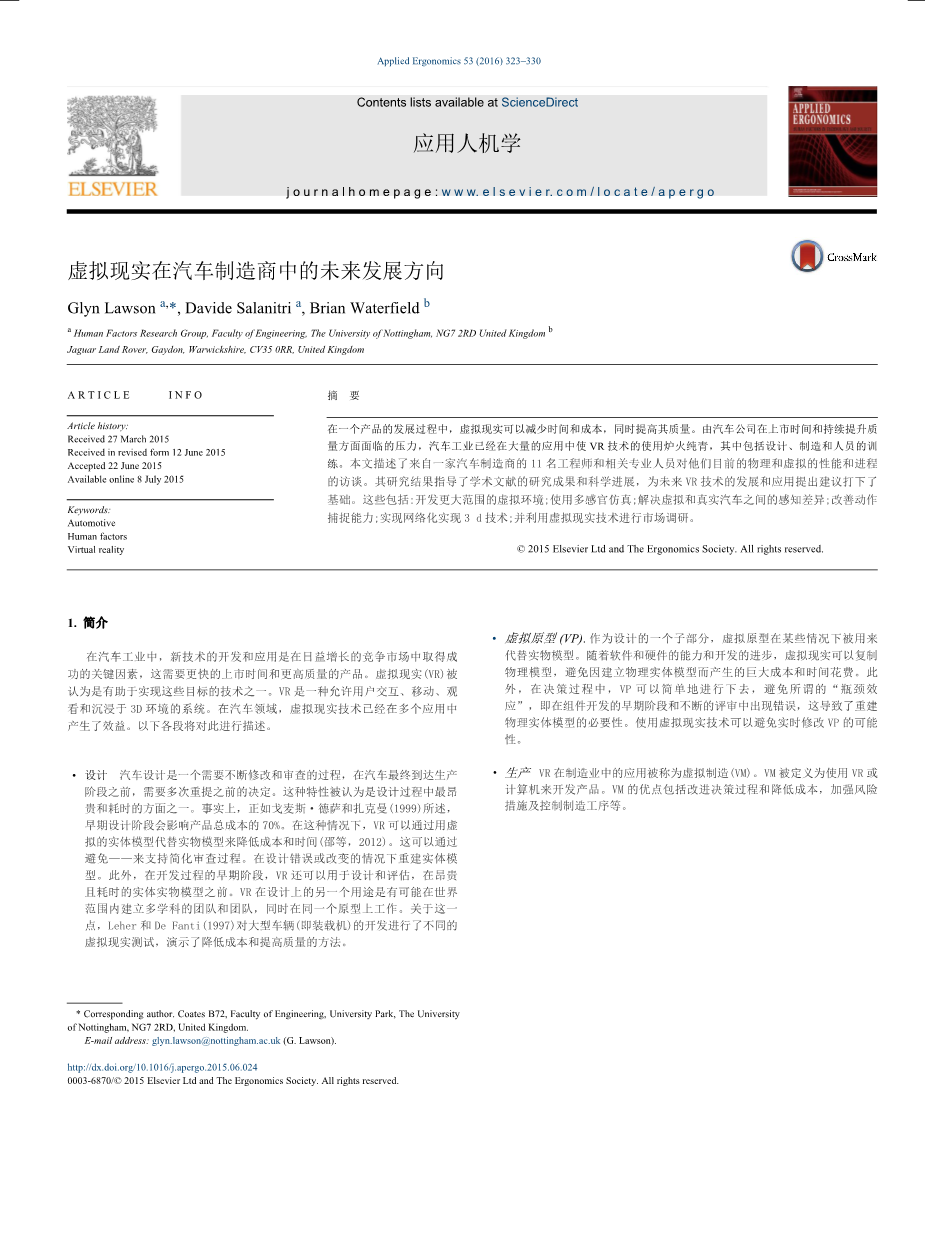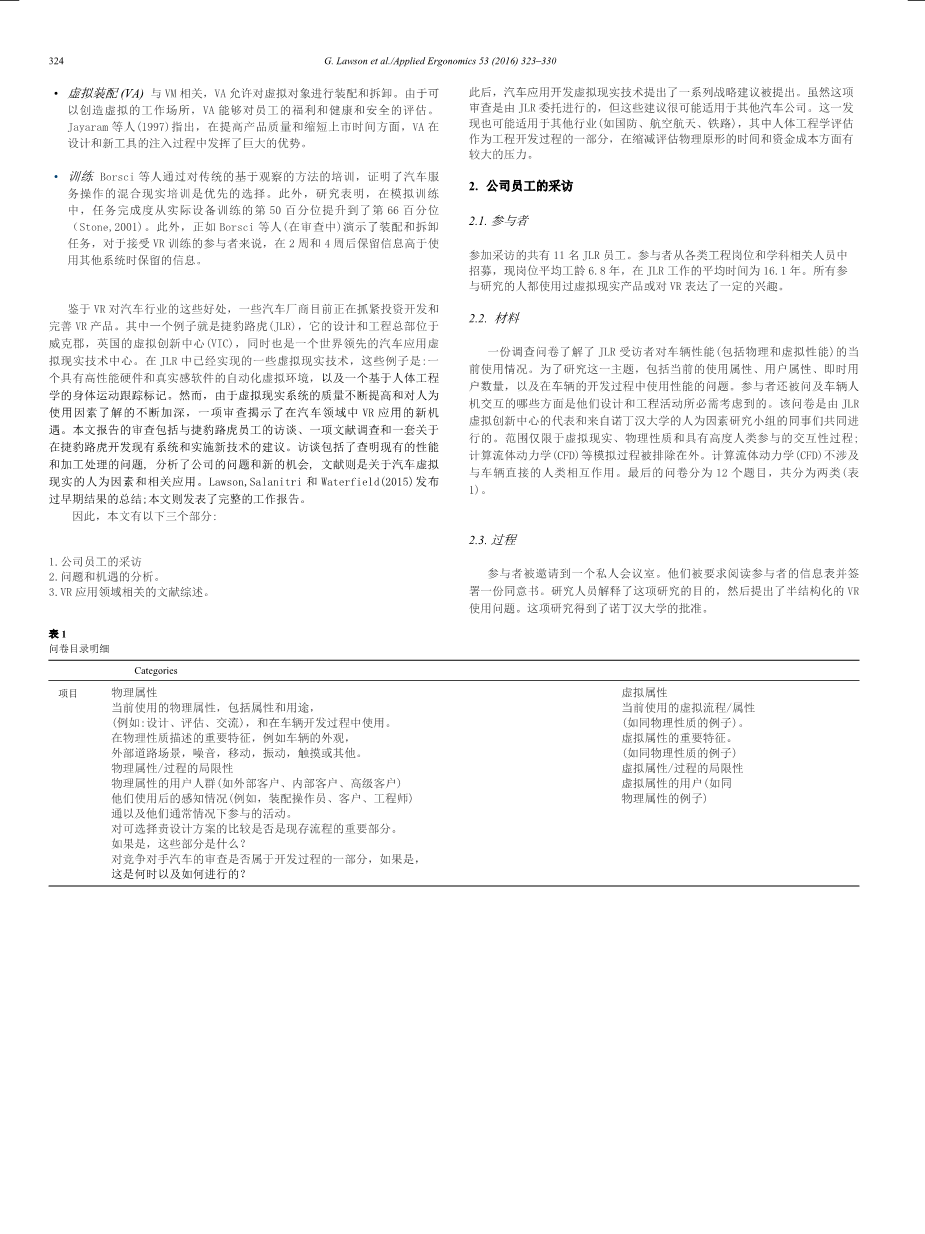

英语原文共 6 页,剩余内容已隐藏,支付完成后下载完整资料
Applied Ergonomics 53 (2016) 323–330
Contents lists available at ScienceDirect
Applied Ergonomics
j o u r n a l h o m e p a g e : w w w. e l s e v i e r. c o m / l o c a t e / a p e r g o
Future directions for the development of virtual reality within an automotive manufacturer
Glyn Lawson a,*, Davide Salanitri a, Brian Waterfield b
a Human Factors Research Group, Faculty of Engineering, The University of Nottingham, NG7 2RD United Kingdom b Jaguar Land Rover, Gaydon, Warwickshire, CV35 0RR, United Kingdom
A R T I C L E I N F O
Article history:
Received 27 March 2015
Received in revised form 12 June 2015 Accepted 22 June 2015
Available online 8 July 2015
Keywords:
Automotive
Human factors
Virtual reality
A B S T R A C T
Virtual Reality (VR) can reduce time and costs, and lead to increases in quality, in the development of a product. Given the pressure on car companies to reduce time-to-market and to continually improve quality, the automotive industry has championed the use of VR across a number of applications, including design, manufacturing, and training. This paper describes interviews with 11 engineers and employees of allied disciplines from an automotive manufacturer about their current physical and virtual properties and pro-cesses. The results guided a review of research findings and scientific advances from the academic literature, which formed the basis of recommendations for future developments of VR technologies and applica-tions. These include: develop a greater range of virtual contexts; use multi-sensory simulation; address perceived differences between virtual and real cars; improve motion capture capabilities; implement net-worked 3D technology; and use VR for market research.
copy; 2015 Elsevier Ltd and The Ergonomics Society. All rights reserved.
1. Introduction
In the automotive industry the development and application of new technologies is a key factor for success in an increasingly com-petitive market that requires faster time-to-market and ever higher quality of products (Choi and Cheung, 2008; Lawson, Salanitri and Waterfield, 2015). Virtual Reality (VR) has been seen as one of the technologies that can help achieve these aims (Mujber et al., 2004). VR is a system which permits users to interact, move, look at, and be immersed in a 3D environment (Rheingold, 1991). In the auto-motive domain, VR has resulted in benefits in several applications. These are described in the following paragraphs.
- Design. Car design is a process requiring continuous modifica-tion and reviews, with the necessity to revert to previous decisions several times before the car finally reaches produc-tion (Fiorentino et al., 2002). This characteristic has been seen as one of the most expensive and time consuming aspects of the process. Indeed, as Gomes de Saacute; and Zachmann (1999) stated, the early design phases can impact on up to 70% of the total cost of a product. In this scenario, VR can reduce cost and time by replacing physical mock-ups with virtual ones (Shao et al., 2012). This can support simplification of the review process by avoid-
* Corresponding author. Coates B72, Faculty of Engineering, University Park, The University of Nottingham, NG7 2RD, United Kingdom.
E-mail address: glyn.lawson@nottingham.ac.uk (G. Lawson).
http://dx.doi.org/10.1016/j.apergo.2015.06.024
0003-6870/copy; 2015 Elsevier Ltd and The Ergonomics Society. All rights reserved.
ing the rebuild of physical mock-ups in case of design errors or changes (Kim et al., 2011). Moreover, VR can be used for design and evaluation during an early stage of the development process, before expensive and time-consuming physical mock-ups are pro-duced (Lawson and Burnett, 2015; Lawson et al., 2015). Another utility of VR in design is the possibility of having multidisci-plinary teams and teams spread across the world, to work together on the same prototype at the same time (Mujber et al., 2004). Regarding this, Lehner and De Fanti (1997) tested dis-tributed VR for large vehicle (i.e. loader) development, demonstrating a cost-time reduction and quality increase.
- Virtual Prototyping (VP). As a sub-section of Design, Virtual Pro-totypes are in some instances used to replace physical mock-ups. With recent progress in the capabilities and development of software and hardware, VR can replicate physical models al-lowing for a drastic cost and time reduction derived from the avoidance of building physical mock-ups (Kulkarni et al., 2011). Moreover, in the decision making process, VP can simply pro-cedures and avoid the so called “bottleneck effect” (Fiorentino et al., 2002) which manifests from errors in the early stages of a componentrsquo;s development and constant reviews, leading to the necessity of rebuilding physical mock-ups. With VR this effect could be avoided with the possibility to modify a VP in real time.
- Manufacturing. The application of VR to manufacturing is called Virtual Manufacturing (VM). VM has been defined as the use of VR or computers for the development of a product (


